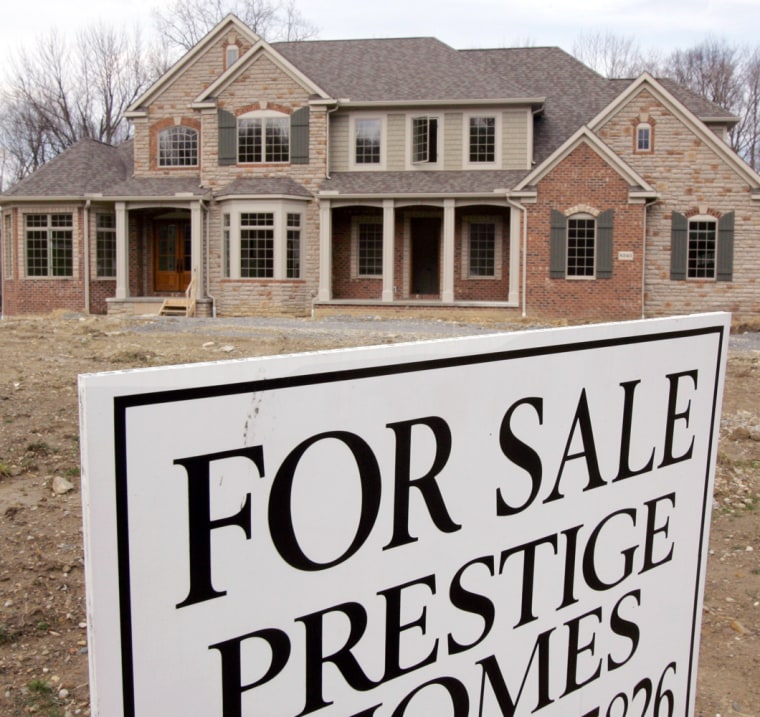Springtime usually means good times in the housing industry, but this year it’s threatening to become a grim season of reckoning.
Signs of a sobering slowdown emerged throughout March, ranging from gloomy forecasts among homebuilders to a growing number of high-risk borrowers struggling to make payments on exotic mortgages they probably couldn’t afford in the first place.
The latest flare came this week as Lennar Corp., one of the nation’s largest homebuilders, reported a 73 percent drop in its first-quarter profit and warned that its results for the remainder of the year won’t live up to previous expectations.
The bleak news threatens to weigh on already drooping home prices, a factor that could undermine potential sales: prospective sellers may hold off on selling in hopes of a turnaround, while prospective buyers may procrastinate in hopes of getting an even better deal later in the year.
The additional dent in home sales could further undermine the overall economy, eroding demand for home furnishings and materials for renovations.
Reflecting the worries about the growing threat to the overall economy, economist Steven Cochrane says the risk of recession beginning later this year are increasing. He estimates there is a 25 percent chance of a recession within six months, up from 20 percent in February.
“Things seem to be snowballing very quickly,” said Cochrane, a senior economist with Moody’s Economy.com. “It’s going to be a weak spring.”
Investors on the Chicago Mercantile Exchange are turning more pessimistic too. A housing futures index tracking 10 major U.S. cities is now projecting January 2008 prices in those markets will be down 5.1 percent from early 2007. At the end of February, the same futures index put together by Tradition Financial Services had forecast a 3.7 percent drop.
“This isn’t going to be over in a year,” predicted Yale University economics professor Robert Shiller, who helped create the housing index. “Housing prices could be declining for years and years.”
Other veteran market observers are more sanguine.
“We don’t think the market is in that bad of shape,” said John Karevoll, an industry analyst for DataQuick Information Systems. “It’s just not in as good shape as it was two years ago.”
Some real estate markets are holding up remarkably well. In Southern California, for instance, a mid-priced home sold for a record high of $495,000 in February, a 5 percent increase from the previous year, according to DataQuick. Although the numbers haven’t been crunched yet, Karevoll believes Southern California home prices reached another new high during March.
Nationally, by contrast, a mid-priced existing home sold for $212,800 in February, down 1.3 percent from last year.
The good times in California probably won’t last much longer, according to a quarterly index that measures the risk of a real estate downturn. The index, compiled by PMI Mortgage Insurance Co., estimates there’s more than a 50 percent chance that home prices will fall during the next two years in eight California markets, including the Los Angeles and San Diego areas.
Nationally, 19 major metropolitan markets face a greater than 50 percent chance of housing price depreciation during the next two years, up from 11 markets a year ago, PMI said.
The somber outlook marks a dramatic shift from the euphoria that prevailed in 2005. Years of steadily rising home prices had spawned a giddy, greed-driven atmosphere that seemed to make people forget about a basic law of economic gravity: what goes up eventually comes down.
As housing prices soared, lenders entrusted more money to borrowers who probably would have been turned away under more normal market conditions.
The risky behavior propelled the rapid growth of subprime mortgages — home loans designed for borrowers with blemished credit histories. By some estimates, about $1.3 trillion has been lent to subprime borrowers across the country. That’s nearly as large as California’s economy.
Subprime mortgages invariably carry higher interest rates, but lenders lessened the burden by charging extremely low introductory rates or initially waiving all interest payments. Some borrowers weren’t even required to provide proof of their incomes to qualify for the most exotic mortgages.
Lenders made these loans largely because they felt protected by rising home prices: As long as property values were climbing, subprime borrowers would be able to refinance into another affordable mortgage once the payments on their earlier loans increased. If that didn’t work, subprime borrowers would be able to bail out by selling their homes at a tidy profit.
But weakening home prices have exposed the folly of that premise. With borrowers defaulting on their mortgages, more than two dozen subprime lenders have closed or filed for bankruptcy.
“Giving mortgages to people who couldn’t afford them was the biggest error of recent years,” Shiller said.
Pressured by federal regulators, subprime lenders have turned off their spigots.
The tougher lending standards are expected to remove 100,000 to 250,000 potential buyers from the housing market during the next two years, estimated David Lereah, chief economist for the National Association of Realtors. That by itself could decrease home sales by up to 3 percent.
“It’s problematic, but not catastrophic,” said Lereah, who is counting on still-low mortgage rates and a strong labor market to help soften the subprime blow.
If the Federal Reserve Bank cuts interest rates later this year, it could help reduce the foreclosure rate by lowering the monthly payments of troubled borrowers with adjustable rate mortgages.
It probably will take months to get a handle on the damage caused by the subprime mortgage spree. The severity will largely depend on how many delinquent borrowers lose their homes to lenders in foreclosures. Mass foreclosures could create a glut of homes on the market, squashing property values even more.
Homebuilders have been hard hit. In addition to Lennar, KB Home, Hovanian Enterprises Inc. and Toll Brothers Inc., also have reported disappointing earnings.
D.R. Horton Inc.’s chief executive, Donald Tomnitz, probably summed it up best in early March when he publicly declared the housing business will “suck” the entire year.
